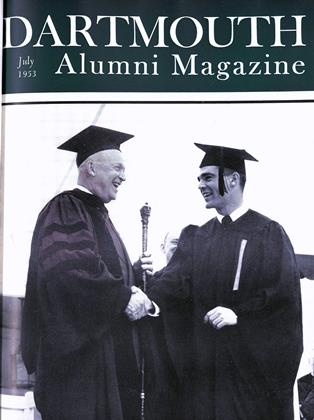Richard C. Colton '25 and William D.Rankin. New York: Funk if Wagnalls Company,1953, 423 pp. $6.00.
In writing the second edition of his well known Practical Handbook of IndustrialTraffic Management, Richard C. Colton '25 - now vice president of Lykes Brothers, largest American-owned steamship company was assisted by William D. Rankin, Rates and Routing Supervisor, The Western Electric Company, Inc. The two men bring together more than fifty years of practical on-the-job industrial traffic experience for the benefit of their readers.
As in the first edition, the major emphasis of the book is on the scope of the industrial traffic manager's job and on his opportunities to lower his company's operating costs through intelligent purchase of transportation services. Full consideration is given to such technical matters as bills of lading, height classification and rates, routing, tracing, and demurrage, siding and weight agreements.
The point of view of the authors is that "a business concern should purchase its transportation with the same care and acumen that it uses in purchasing its raw materials." They leave no doubt as to the extent of the unnecessary costs for premium transportation services resulting from faulty sales and production planning and control, supplier delivery failures, or overly enthusiastic expediting service. Profit-minded managements would do well to adopt the "premium or excess transportation cost report" suggested by Colton and Rankin as a means of spotlighting wasteful transportation purchasing.
The casual reader of this book will be impressed by the range of detailed knowledge required for successful work in this rapidly developing field of industrial management, while the business executive who has been accustomed to operating without a traffic department will be reminded constantly of the hidden costs involved in the unskilled purchase of transportation services. For the top executive, the advantages of closely coordinating the work of such specialists as the packaging engineer, the materials handling engineer and the traffic manager are presented.
In summary, this is a book to be read by (1) business executives interested in obtaining better control of transportation costs in their companies (2) industrial traffic personnel seeking a practical reference written by men with years of experience and (3) students desirous of obtaining a working knowledge of the scope of this important management function.
 View Full Issue
View Full Issue
More From This Issue
-
 Cover Story
Cover StoryThe President's Eighteen Hours in Hanover
July 1953 By ADRIAN BOUCHARD -
 Article
ArticleThe 1953 Commencement
July 1953 -
 Article
ArticleThe Commencement Address
July 1953 By THE HON. LESTER B. PEARSON '53h -
 Class Notes
Class Notes1918 Holds Its 35th
July 1953 By ERNEST H. EARLEY '18, -
 Class Notes
Class NotesThe Big 25th for 1928
July 1953 By OSMUN SKINNER '28, -
 Class Notes
Class Notes1937's Delayed 15th
July 1953 By ROBERT C. BANKART '37
KARL A. HILL '38
Books
-
 Books
BooksSECOND WIFE.
DECEMBER 1963 By CLIFF JORDAN '45 -
 Books
BooksBriefly Noted
APRIL 1969 By J.H. -
 Books
BooksSPUN SEQUENCE.
July 1962 By RICHARD EBERHART '26 -
 Books
BooksTHE LOGIC OF LANGUAGE
November 1939 By Stearns Morse -
 Books
BooksTHE RESEARCH HANDBOOK: A GUIDE TO REFERENCE SOURCES.
JUNE 1966 By VIRGINIA A. CLOSE -
 Books
BooksHOSPITAL POLICY DECISIONS PROCESS AND ACTION.
JUNE 1966 By WILLIAM L. WILSON '34



